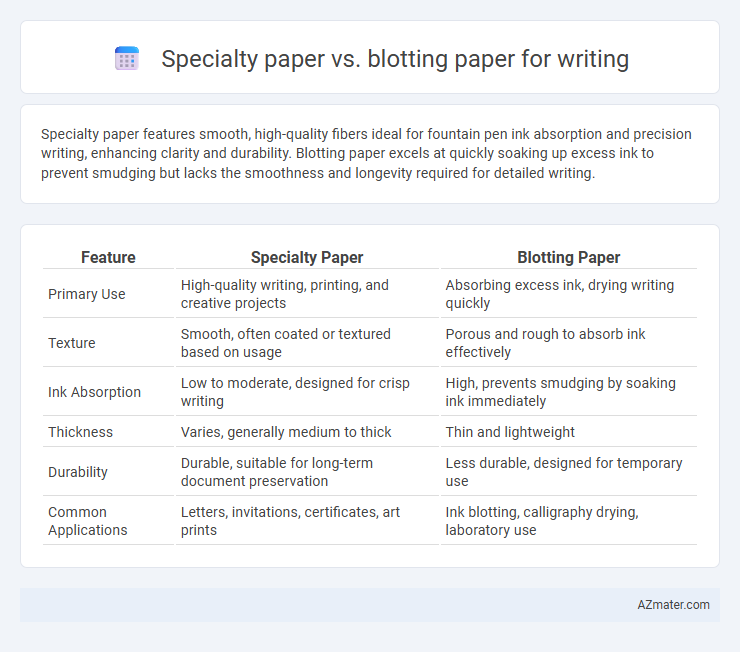Specialty paper features smooth, high-quality fibers ideal for fountain pen ink absorption and precision writing, enhancing clarity and durability. Blotting paper excels at quickly soaking up excess ink to prevent smudging but lacks the smoothness and longevity required for detailed writing.
Table of Comparison
| Feature | Specialty Paper | Blotting Paper |
|---|---|---|
| Primary Use | High-quality writing, printing, and creative projects | Absorbing excess ink, drying writing quickly |
| Texture | Smooth, often coated or textured based on usage | Porous and rough to absorb ink effectively |
| Ink Absorption | Low to moderate, designed for crisp writing | High, prevents smudging by soaking ink immediately |
| Thickness | Varies, generally medium to thick | Thin and lightweight |
| Durability | Durable, suitable for long-term document preservation | Less durable, designed for temporary use |
| Common Applications | Letters, invitations, certificates, art prints | Ink blotting, calligraphy drying, laboratory use |
Introduction to Specialty Paper and Blotting Paper
Specialty paper encompasses a range of high-quality papers designed for specific applications, including artistic writing, calligraphy, and archival purposes, offering smooth textures and enhanced durability. Blotting paper, characterized by its high absorbency, is primarily used to absorb excess ink from writing surfaces, preventing smudging and improving drying times. Understanding the unique properties of specialty paper and blotting paper is essential for selecting the appropriate medium to achieve optimal writing performance and presentation.
Defining Specialty Paper: Purpose and Types
Specialty paper refers to high-quality, purpose-driven paper designed for specific applications such as art, printing, and packaging, offering unique textures and durability. It includes types like textured papers, coated papers, and archival paper, each engineered to enhance writing, drawing, or printing performance. Blotting paper, a subtype of specialty paper, specifically absorbs excess ink to prevent smudging and improve drying times in handwritten documents.
Blotting Paper Explained: Uses in Writing
Blotting paper is specifically designed to absorb excess ink quickly, preventing smudging and allowing for sharper, clearer handwriting. Unlike specialty paper, which may enhance appearance or texture, blotting paper's primary function is practical, improving the drying time of ink from fountain pens and calligraphy nibs. Its high absorbency makes it essential in traditional writing environments to maintain legibility and prevent ink stains on documents.
Key Differences in Material Composition
Specialty paper often consists of high-quality fibers such as cotton or linen, designed for durability and smoothness ideal for writing instruments like fountain pens. Blotting paper, made from highly absorbent cellulose fibers, functions primarily to absorb excess ink quickly without smudging, featuring a porous texture that limits its use for direct writing. These fundamental distinctions in fiber composition and absorbency determine their specific applications in writing and ink management.
Writing Experience: Specialty Paper vs Blotting Paper
Specialty paper provides a smooth, consistent texture ideal for fountain pen users seeking precise ink flow and vibrant color retention, enhancing the overall writing experience. Blotting paper absorbs excess ink quickly, preventing smudges but offering a rougher surface that can affect pen glide and detailed strokes. Writers requiring clean, sharp lines prefer specialty paper, while blotting paper suits those prioritizing fast drying and minimal ink spread.
Ink Absorption and Smudge Prevention
Specialty paper designed for writing typically features a smooth surface with moderate ink absorption to prevent feathering and ensure sharp text, whereas blotting paper excels in absorbing excess ink rapidly to reduce smudging. The high absorbency of blotting paper makes it ideal for wet ink but can cause uneven ink distribution if used as a writing surface. Specialty papers balance ink absorption with smudge prevention, providing a clean finish without sacrificing writing clarity.
Durability and Texture Comparison
Specialty paper for writing typically offers enhanced durability due to its higher-quality fibers and coatings that resist wear and smudging, making it ideal for long-lasting documents. Blotting paper features a highly absorbent, rough texture designed primarily to soak up excess ink quickly, which can cause ink to spread and affect legibility on delicate writing surfaces. Comparing texture, specialty paper usually has a smoother finish that promotes clean, crisp writing, whereas blotting paper's porous, coarse texture is less suitable for direct writing but excellent for drying ink without smearing.
Applications in Calligraphy and Fine Writing
Specialty paper designed for calligraphy offers a smooth, acid-free surface that enhances ink flow and prevents feathering, making it ideal for intricate, fine writing and decorative scripts. Blotting paper, composed of highly absorbent fibers, is primarily used to quickly dry ink and prevent smudging, especially with fountain pens and dip pens, but it lacks the structural qualities needed for detailed writing. Calligraphers often select specialty paper to maintain precision and clarity in strokes, while blotting paper serves as an essential tool to preserve the quality of writing by managing excess ink.
Cost and Availability Considerations
Specialty paper designed for writing tends to have a higher cost due to quality materials and specific finishes that enhance ink absorption and appearance, whereas blotting paper is generally more affordable and widely available as it primarily serves to absorb excess ink. Availability of specialty writing paper is often limited to stationery stores or online suppliers specializing in high-quality or artistic paper, while blotting paper can be found in general office supply stores and pharmacies. Choosing between the two depends on budget constraints and accessibility, with blotting paper being the economical choice for everyday use and specialty writing paper preferred for professional or artistic purposes.
Choosing the Right Paper for Your Writing Needs
Specialty paper offers a smooth texture and high-quality finish ideal for formal writing, calligraphy, and artistic projects requiring precise ink absorption and vivid color reproduction. Blotting paper excels at quickly absorbing excess ink, preventing smudges and smears, making it essential for fountain pen users and wet ink applications. Choosing the right paper involves assessing ink compatibility, drying time, and the desired presentation quality to ensure crisp, clean writing results.

Infographic: Specialty paper vs Blotting paper for Writing
 azmater.com
azmater.com